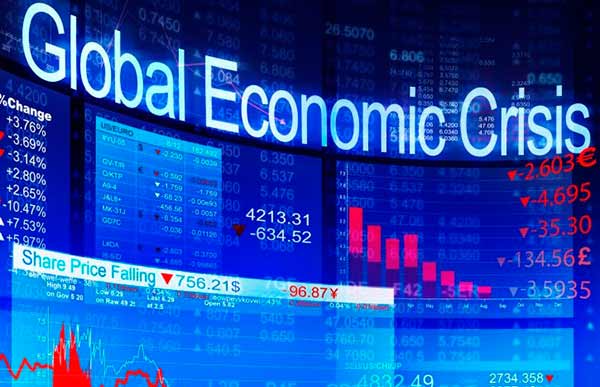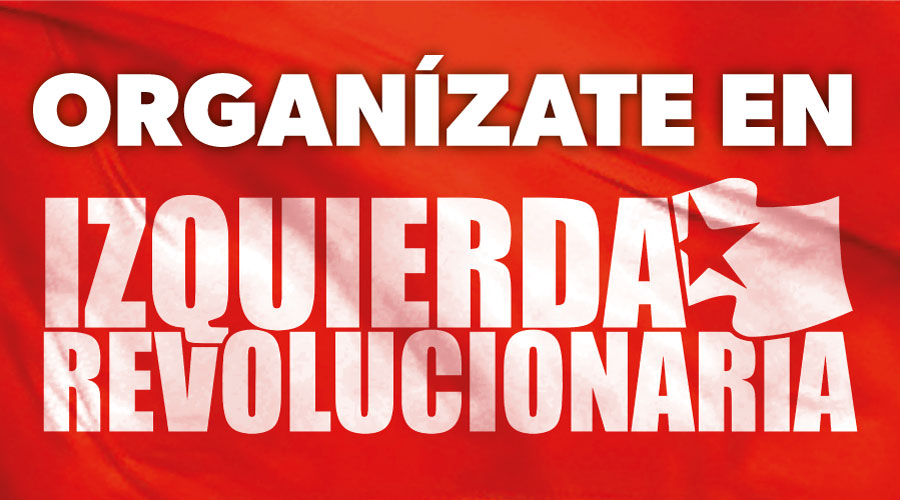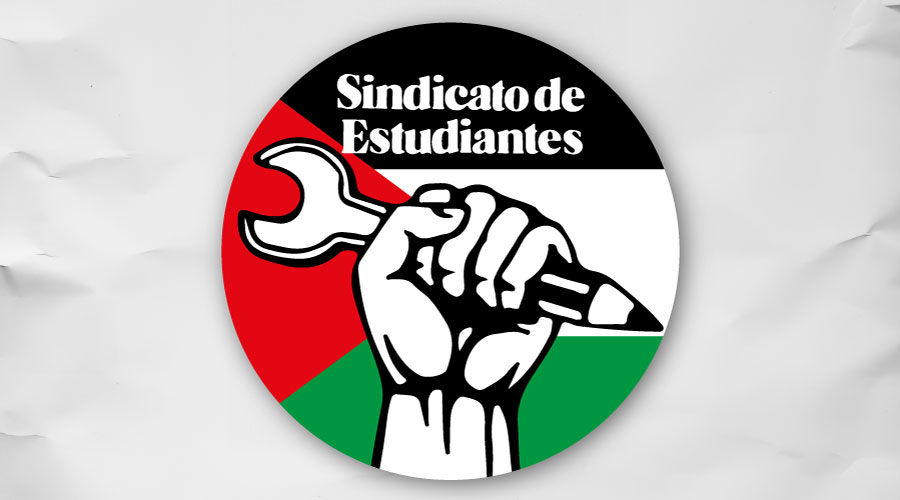The capitalist economy has entered a state of panic. Stock markets around the world have plunged in recent weeks, losing almost 20% of their value, and the price for a barrel of Brent has fallen more than 20% in a single day, a situation not seen since the Gulf War in 1991. The economic data is revised downwards every week, and the banking association has said that world growth will remain at 1%, which implies a situation of global recession.
Sectors such as airlines face losses of up to € 102 billion, a large company having already gone bankrupt. The coronavirus epidemic is highlighting the weakness of the economy and the enormous contradictions and imbalances accumulated over the years, which now threaten to explode violently. However, this virus is only the accident that has made a senile economy seriously ill.
The enormous crisis of legitimacy of capitalism, as a result of the accelerated growth of inequality and misery worldwide, has led one of its traditional spokesmen, the Financial Times, to raise the need to reset capitalism, working mainly "for focusing on maximizing profit and shareholder value.” They are the same ones that in the midst of the great recession of 2007-2008 advocated reestablishing it, stopping its abuses and humanizing it. The problem, however, as Marx and Engels already pointed out, are the laws under which the market operates, which make a capitalism with a human face unfeasible.
A recession with unforeseeable consequences
The capitalist agenda deployed to ward off the 2008 crisis has been unable to respond to the challenge and has worsened the structural contradictions that emerged a decade ago. 2019 closed with a 1% growth in trade compared to the 4% in 2018, the lowest rate in the last decade. Now, after the outbreak of the epidemic, the question is how far this crisis can go.
China, which has contributed a third of world growth in the last ten years, faces its smallest increase in almost 30 years, 4%, according to the Institute of International Finance, after accounting for part of the coronavirus effect. The Asian giant has become a central actor. Its brilliant economic expansion, which has also led to the accumulation of enormous imbalances and contradictions, gave capitalism a lot of stability, but now all this seems to turn to its opposite.
Growth for the US, already moderate in 2019, has been revised downwards: a pyrrhic 1.3% for 2020 for the moment. Its industrial sector, despite Trump's promises, continues to decline. In 2019, 16,000 Rust Belt workers in the US lost their jobs. The US president has had to lift his foot from the accelerator in the tariff war with China, since, among other factors, 77% of Chinese exports correspond to semi-finished products to produce goods in North American industries. The fact that US policy was identified for the first time at the recent Davos Forum as one of the main factors of global instability is a good reflection of the weaknesses of its economy and the type of recovery we are witnessing.
The European Union (EU), which was facing a situation of stagnation, will openly enter a recession, especially Germany with a constant drop in its industrial production. The European locomotive is facing a sharp decline in its exports, which in 2018 contributed 47.4% of its GDP. Car production has registered the lowest figure since 1997, with exports falling by 13% in an industry that exports 77% of its production. This data puts the German economy in check, especially due to the abrupt interruption of world trade. On the other hand, Italy faces a situation of complete economic paralysis, with a huge debt that could explode at any time. Europe's position in the world continues to deteriorate.
Record indebtedness and financial speculation
This critical situation is combined with exponential growth in debt and completely out of control financial speculation. Global debt reaches new records every year, well above the figures prior to the outbreak of the great recession. Public, corporate and family debt in the world reached 253.6 trillion dollars, 322% of world GDP, with a new rise of almost 8 trillion dollars in 2019. 60% of the increase in world debt corresponds to China and the United States, and 70% of the increase in corporate debt corresponds to North American multinationals. On the other hand, the "emerging" countries increased their debt to 72.5 trillion, 223% of their GDP, the "biggest, fastest and most widespread" wave since 1970, according to the World Bank.
This completely anomalous situation exploded last September in the so-called repurchase market (repo) in the US, where banks and stockbrokers go daily to obtain loans. Given the shortage of cash, there was a rise in interest rates from 2.21% to 10%, and the Federal Reserve (Fed) was forced to provide $ 203 billion in a week, the largest injection of liquidity since 2008. Since then it has had to introduce another $ 60,000 million monthly and reduce rates, which due to the effects of the coronavirus, have been cut again, remaining on the verge of 1% and greatly reducing future room for maneuver. Christine Lagarde, President of the ECB, has acknowledged that they are running out of ammunition after negative rates have been installed in the eurozone, especially in Germany: an unprecedented situation that artificially supports an important part of the capitalist economy, driving an uncontrolled speculative spiral that threatens to explode at any moment.
The capitalization of international stock markets has also reached record figures: 86 trillion dollars, 100% of world GDP. This historical growth in profits in the stock markets does not correspond to an advance in the real economy, giving way, in the face of panic, to multimillion-dollar losses. We are faced with an expansion of fictitious capital while productive investment continues to stagnate or collapse, highlighting the role of the repurchase of shares in these increases: Apple alone has spent 239,000 million dollars in the last ten years. We are faced with the dream of capital: to obtain money from money without going through the production process. Something that inevitably ends up colliding with the real economy.
The dictatorship of financial capital and monopolies
Since the great recession, the concentration of wealth and property has taken an unprecedented leap, confirming the innate monopolistic tendencies to capitalist development. The most important bank merger since 2008 between BB&T and SunTrust has recently taken place, which will give rise to the sixth largest financial institution in the US. These six big banks and financial entities will monopolize more than 65% of all the financial assets and deposits of the country. There has also been a merger between Charles Schwab and TD Ameritrade, the first and third largest US stock-exchange and banking brokerage firms. Investment fund managers such as BlackRock, currently the largest in the world, manage capitals worth $ 6.3 trillion, the equivalent of the combined GDP of Germany and France.
When the subprime crisis occurred, sensible bourgeois analysts and economists pointed out as one of the main problems the existence of banks and financial institutions of immense dimensions. Ten years later, the concentration of financial capital is even greater. This process of concentration and monopolization, which debunks the capitalist myth of "free competition", has spread to all sectors of economic activity. In a recent study on climate change, the journal Nature (1) confirmed the extent to which the planet's natural resources, and agricultural, mineral, pharmaceutical or any other sector’s production, have been concentrated in the hands of a tiny handful of large monopolies.
Numerous bourgeois economists, and especially reformist leaders, show their frustration with the current drift of capitalism, longing for better times when capital behaved in a "responsible" way allowing "fair" competition. However, as Marxism already pointed out, the material foundations of that ideal capitalism have long since disappeared: “The elimination of competition for monopoly marks the beginning of the disintegration of capitalist society. Competition was the main creative mechanism of capitalism and the justification of the capitalist. Therefore, the elimination of competition marks the transformation of shareholders into social parasites” (2).
Protectionism and trade war
The bourgeois media blames this situation on the trade war. Despite the fact that everyone agrees that a tariff and protectionist escalation is negative for the capitalist economy as a whole, and that it could lead to a recession and even an economic depression, as happened during the thirties of the last century, the objective tendencies of capitalism push inexorably in that direction. The bourgeoisie would like to stop this process, but the laws that govern its system make it very complicated. The recession will strengthen those trends, making “every man for himself” prevail.
Protectionist policies are not an invention by Donald Trump. Since 2008, countries around the world have approved 10,035 rules of economic protectionism opposite 3,544 liberalizing measures. This dynamic, as in other moments in history, has been imposed as a result of the overproduction crisis and the need of the different bourgeoisies to compete more fiercely for the world market.
In the year 2000, China only surpassed the USA as the main trading partner in Cuba, Paraguay, Iraq, Iran, a dozen African countries and its border countries in Southeast Asia. Today it has become the main trading and exporting partner of all countries in Africa, Asia and Oceania, and of most of Europe and Latin America. The USA maintains its pre-eminence only with respect to Canada and Mexico, in Europe with Great Britain, Ireland, France and Switzerland, in a couple of countries in Africa, and in Central America, Colombia and Ecuador. This enormous setback of US-imperialism explains the worsening of the trade war and the strategic commitment of the American bourgeoisie to fight this battle.
The alleged truce reached between the US and China is pure propaganda. This type of agreement can only be partial and temporary, threatened by any new event, since we are witnessing a decisive struggle for world supremacy between these two actors. However, Trump's vociferous nationalist rhetoric should not lead us into confusion. The concrete reality is that in these four years of presidency, his government and the American bourgeoisie have not been able to advance one iota in the international sphere. Conversely, all their attempts to revert the regression of US imperialism have failed.
For this reason, weeks after the signing of the alleged truce, the confrontation has erupted around Huawei, now accused by the United States government of criminal organization for the theft of intellectual property. In 2019 Huawei displaced Apple from second to third place worldwide in mobile sales, and currently five of the ten largest Internet and telephone companies are Chinese, while in 2009 all ten were North American. One of the main points of confrontation is the development of the new 5G technology. China has already installed 400,000 5G stations, ten times more than the US; signed agreements with 60 countries for the development of this new network (many of them allies of the United States); and it is estimated that in 2025 it will have 650 million users, 40% worldwide. The central issues of conflict (Beijing's subsidies to certain industries, intellectual property and technological warfare) have been left out of the agreements. The US Department of Defense has warned that "China is preparing to repeat with 5G what happened with 4G in the US", transforming "a manufacturing economy that is capital and labor intensive, into a system led by innovation and consumption, with a decreasing dependence on foreign investment and technology”.
Social polarization and inequality
All this precarious situation in the world economy is combined with an unprecedented growth of misery and inequality, confirming the predictions of Marx and Engels in The Communist Manifesto. The latest annual report from Intermon Oxfam indicates that the richest 1% of the population has twice as much wealth as 6.9 billion people. At the same time, the number of billionaires has doubled.
The widespread precariousness of the workforce and low wages have given rise in developed countries to the proliferation of the figure of the worker who, despite having one or two jobs, remains on the brink of poverty or in poverty. This report reflects the following: "a worker who is located today in the 10% of the poorest workers, should work three and a half centuries to get the same income as a worker who is located in the 10% of the richest workers". While 10% of the workers with the highest salaries receive almost 50% of the world wage bill, 20% with the lowest salaries do not reach 1%.
It is this situation that is behind the explosions and revolutionary uprisings in a large part of the planet, from Chile or Bolivia, passing through Algeria, Lebanon, Iraq, to France or Catalonia. Countries like the United States or Great Britain, bastions of capitalist stability in the past, are corroded by extreme social polarization, giving rise to phenomena such as that of Bernie Sanders. The class struggle is unremitting and hence the deep pessimism among the ruling class. The conditions of the revolution are fully mature, but the absence of the subjective factor, a mass revolutionary party capable of channeling the energy, anger and frustration of the working class and youth, does not allow the overthrow of capitalism. That is therefore the task of the moment!
(1). Four multinationals control 84% of the pesticide market, ten 56% of the fertilizer market, another ten 83% of the livestock pharmacist, and three companies 60% of the seed market. In mining, five multinationals account for 91%, 88% and 62% of the world production of platinum, palladium and cobalt, and ten multinationals for 64%, 52%, 50% and 45% of the production of nickel, iron, copper and zinc respectively, as well as 34% and 30% of silver and gold. 72% of oil reserves and 51% of gas reserves are in the hands of a dozen multinational companies, while many others produce 30% of world cement. There are also ten that account for 25% of world paper and cardboard production, and thirteen that account for between 11 and 16% of world fisheries and between 20 and 40% of fish stocks. Five multinationals control 90% of world palm oil trade, another three 60% of cocoa production, ten 40% of coffee production, eight 54% of soybean production, three 42% of the banana production and five 48% of salmon production.
(2). Fundamentos de economía marxista. El marxismo en nuestro tiempo, Leon Trotsky. Federico Engels Foundation, 2019.




















































